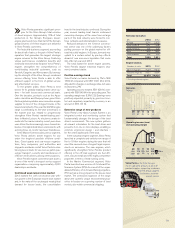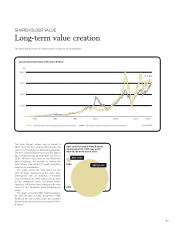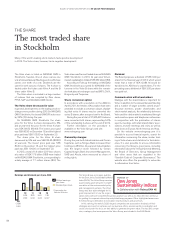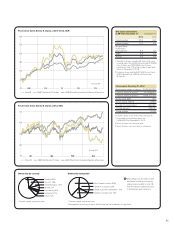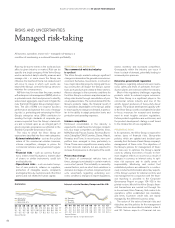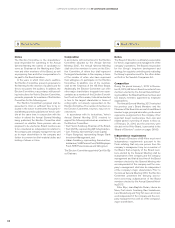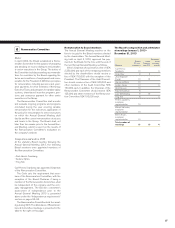Volvo 2013 Annual Report Download - page 91
Download and view the complete annual report
Please find page 91 of the 2013 Volvo annual report below. You can navigate through the pages in the report by either clicking on the pages listed below, or by using the keyword search tool below to find specific information within the annual report.
described briefl y in the following paragraphs.
Volvo Group’s accounting policies for fi nancial
in struments are described in note 30. The over-
all impact on a company’s competitiveness is
also affected however by how various macro -
economic factors interact.
Interest-related risk
Interest-related risk includes risks that changes
in interest rates will impact the Group’s income
and cash fl ow (cash-fl ow risks) or the fair value
of fi nancial assets and liabilities (price risks).
Currency-related risk
More than 90% of the net sales of the Volvo
Group are generated in countries other than
Sweden. Changes in exchange rates have a di -
rect impact on the Volvo Group’s operating in -
come, balance sheet and cash fl ow, as well as
an indirect impact on Volvo’s competitiveness,
which over time affects the Group’s earnings.
Credit-related risk
An important part of the Group’s credit risk is
related to how the fi nancial assets of the Group
have been placed. The majority are placed in
interest-bearing bonds issued by Swedish real
estate fi nancing institutions.
Liquidity risk
The Volvo Group ensures its fi nancial prepared-
ness by always maintaining a certain portion of
revenues in liquid assets.
Market risk from investments in shares
or similar instruments
The Volvo Group is indirectly exposed to market
risks from shares and other similar instruments,
as a result of managed capital transferred to
independent pension plans being partly invested
in instruments of these types. Please see note
20 for further information.
OPERATIONAL RISK
The profi tability depends on successful
new products
The Volvo Group’s long-term profi tability de pends
on the Company’s ability to successfully launch
and market its new products. Product life cycles
continue to shorten, putting increased focus on
the success of the Group’s product development.
Reliance on suppliers
The Volvo Group purchases raw materials, parts
and components from numerous external sup-
pliers. A signifi cant part of the Group’s require-
ments for raw materials and supplies is fi lled by
single-source suppliers. The effects of delivery
interruptions vary depending on the item or com-
ponent. Certain items and components are stand-
ard throughout the industry, whereas others are
internally developed and require unique tools that
are time- consuming to replace.
The Volvo Group’s costs for raw materials and
components can vary signifi cantly over a busi-
ness cycle. Cost variations may be caused by
changes in world market prices for raw materi-
als or by an inability of our suppliers to deliver.
Intangible assets
AB Volvo owns or otherwise has rights to pat-
ents and brands that refer to the products the
Company manufactures and markets. These
have been acquired over a number of years and
are valuable to the operations of the Volvo
Group. AB Volvo does not consider that any of
the Group’s operations are heavily dependent
on any single patent or group of patents.
Through Volvo Trademark Holding AB, AB Volvo
and Volvo Car Corporation jointly own the Volvo
brand. AB Volvo has the exclusive right to use the
Volvo name and trademark for its products and
services. Similarly, Volvo Car Corporation has the
exclusive right to use the Volvo name and trade-
mark for its products and services.
The Volvo Group’s rights to use the Renault
brand are restricted to the truck operations only
and are regulated by a license from Renault
s.a.s., which owns the Renault brand. The amount
paid during 2013 to Renault s.a.s. for license fees
amounted to SEK 5.2 M (6.4).
The Volvo Group’s rights to use the Panhard
brand are regulated by a license from Peugeot
SA. The amount paid during 2013 to Peugeot
SA for license fees amounted to SEK 87,000
(90,000).
Complaints and legal actions
The Volvo Group could be the target of com-
plaints and legal actions initiated by customers,
employees and other third parties alleging
health, environmental, safety or business related
issues, or failure to comply with applicable leg-
islation and regulations. Information about legal
proceedings involving entities within the Volvo
Group are found in note 24 Contingent Liabilities.
Even if such disputes are resolved success-
fully, without having adverse fi nancial conse-
quences, they could negatively impact the
Group’s reputation and take up resources that
could be used for other purposes.
Risk related to human capital
A decisive factor for the realization of the Volvo
Group’s vision is our employees and their knowl-
edge and competence. Future development de -
pends on the company’s ability to maintain its
position as an attractive employer. To this end,
the Volvo Group strives for a work environment
in which energy, passion and respect for the
individual are guiding principles. Every year a
Group-wide survey is conducted, and according
to the survey the share of satisfi ed employees
has been on a high level in recent years.
SHORT-TERM RISK FACTORS
An increase in demand could potentially result
in delivery disturbances due to suppliers’ fi nan-
cial instability or shortage of resources.
Uncertainty regarding customers’ access to
the fi nancing of products in emerging markets
might have a negative impact on demand.
The Volvo Group verifi es annually, or more
frequently if necessary, the goodwill value and
other intangible assets for possible impairment.
The size of the overvalue differs between the
business areas and they are, to a varying de -
gree, sensitive to changes in the business envi-
ronment. Instability in the business recovery and
volatility in interest and currency rates may lead
to indications of impairment.
For further information on intangible assets,
see note 12.
The reported amounts for contingent liabili-
ties refl ect a part of the Volvo Group’s risk expo-
sure, see note 24 for contingent liabilities.
Contractual conditions
related to take over bids
Some of AB Volvo’s long term loan agreements
contain conditions stipulating the right for a
bondholder to request repayment in advance
under certain conditions following a change of
the control of the company. In AB Volvo’s opin-
ion it has been necessary to accept those con-
ditions in order to receive fi nancing on other-
wise acceptable terms. Provisions stipulating
that an agreement can be changed or termi-
nated if the control of the company is changed
are also included in some of the agreements
whereby Renault Trucks’ has been given the
right to sell Renault s.a.s.’ and Nissan Motor Co.
Ltd’s light-duty trucks as well as in some of the
Group’s purchasing agreements.
Further information
Note 27 Personnel contains information
concerning rules on severance payments
applicable for the Group Executive Team and
certain other senior executives.
Note 4 and 30 contain information regarding
fi nancial risks as well as goals and policies in
fi nancial risk management.
Further risk information is provided in note 24.
Information about licensable facilities in Sweden
is provided on page 46.
87




